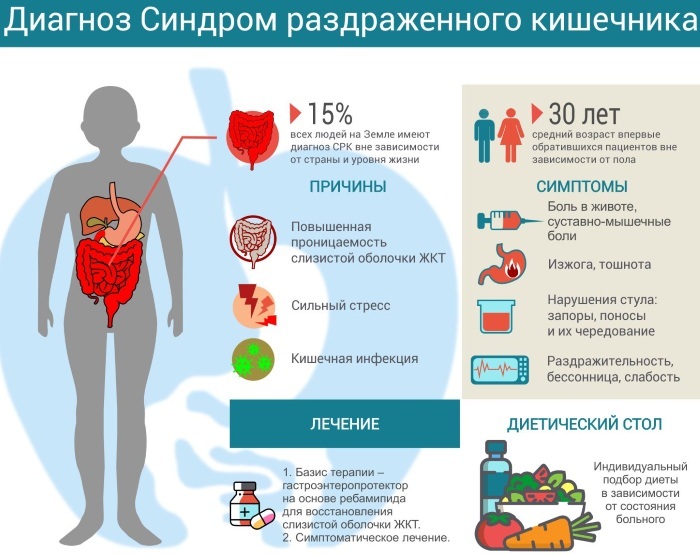Content
- The concept of motive and motivation in psychology
- Types of motives
- Internal and external
- Positive and negative motives
- Resistant and unstable
- Achieving Success
- Functions of motives
- Levels and types of motivation
- The main motives of a person, examples
- What is subordination of motives?
- The problem of the struggle of motives
- How to correctly identify motive and motivation?
- Video about motives in psychology
Behavior of any individual subject to motive. It is the determining factor and driving force behind actions or purposeful actions. In psychology, this concept is understood as a motivation that influences decision-making. Another meaning of the term is the reason for choosing a path to achieve a goal or satisfy a need.
The concept of motive and motivation in psychology
Definitions differ in their meaning. Often they complement each other or form a complex system of behavioral reactions, choice of the type of activity. In a simplified version, a motive means a reason or motivation for a certain action.
Motivation is the driving force that serves as a product of mental activity, generated by a stable psycho-emotional state, views or worldview. It forces you to make long-term decisions.
Motive is a narrower concept in psychology that stimulates behavioral activity and is aimed at quickly achieving a goal. Both terms were coined by the German philosopher Arthur Schopenhauer. Understanding the conceptual difference between the two is important in assessing the factors governing an individual's behavior.
Psychologists have a dual meaning in motivation. On the one hand, this is a set of motives, on the other, a process of a set of actions aimed at achieving goals in the long term. Motivation is a multifactorial system that determines social or biological behavior.

The desire to achieve a specific result of activity serves as a goal and at the same time as a stimulating circumstance for activity. The motive is often presented in the form of a special emotional experience that is transformed into directed action. Motivation is used when choosing a path.
The motive acts when making local decisions within the framework of a general direction or vector. It can be presented in the form of a generalized speculative image of material or idealistic values that are the subject of striving, claims, lust.
Types of motives
The psychological category is difficult to classify. There are innumerable circumstances that motivate action. They often do not fit into the framework of well-defined concepts. Each school of psychology develops its own system for classifying motives.
In the generally accepted view, they are:
- hidden;
- explicit;
- social;
- household;
- physiological;
- biological.
Depending on the nature or focus, motives are classified according to content, origin, duration. There are varieties, distributed according to the strength of manifestation, level of awareness, sphere of activity.
In terms of content, the following types of motives are distinguished:
- Ideological. They affect the ideological part of the personality. Such motives are guided even at the risk of harming themselves.
- Political. To a large extent they overlap with the previous version. Such motives reflect the political position of the individual. They are often based on the desire for leadership, recognition, popularity.
- Moral and ethical. Determine public behavior, indicate a clear framework for what is acceptable. This type of motives is based on generally accepted principles of morality, which are not the same in different social formations.
- Aesthetic. The most harmless, constructive category of motives. They are guided by them when choosing the profession of an artist, musician or designer.
Classification by origin (source) divides the motivating factors into social, collective, incentive. This includes labor motives that are formed under the influence of professional affiliation or type of activity.
Social behavioral criteria take into account the interests and rules of the social formation that a person belongs to. Many everyday actions are subordinated to this type of motive.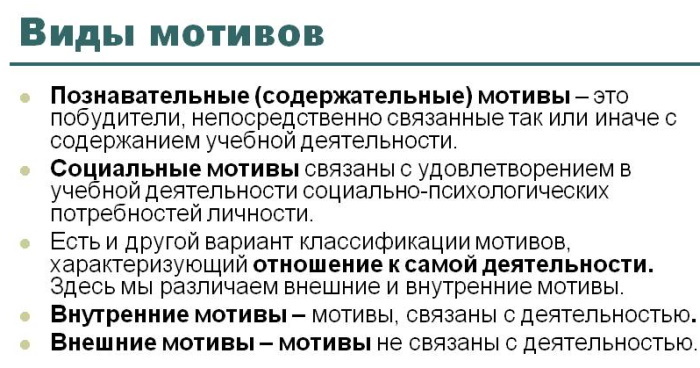
Collective incentives involve taking into account the interests of the group to which the individual belongs. Incentive motives force you to leave your own comfort zone for the sake of achievement or striving for new heights in life.
Such behavior is always based on a thirst for material goods. This is the most important type of motive that makes you learn, make discoveries and inventions. Below are 4 main generalized groups of stimuli.
Internal and external
Such incentives are of immense importance in choosing a goal and determining the means to achieve it. They are aimed at revealing their own potential, manifesting individuality.
A motive in psychology is an internal urge or an external circumstance that prompts a certain action. The first is associated with the emotional state, worldview, the spectrum of interests of the individual.
Internal motives are aimed at:
- increased self-esteem;
- realization of natural abilities;
- satisfying the need for positive emotions;
- achievement of life comfort;
- acquisition of material goods;
- fulfilling one's own duty;
- a manifestation of love and care for loved ones.
Such stimuli for action are considered stable, unchanged over time. For example, a student's desire to learn a lesson is due to internal motives - interest in a subject, a thirst for new knowledge, a desire to get a high score.
It brings moral satisfaction from a job well done. External motives are associated with circumstances that indirectly or indirectly depend on the will of a person, the scope of his efforts.
A typical example is choosing wardrobe items for the season or wanting to take an umbrella with you while waiting for the rain. Public opinion, comfort, whims of nature do not depend on the internal factors of the personality. They create motives called external.
Good performance of the assigned work, professional duties, the desire for personal growth are aimed at increasing their own value in the labor market. Here, there is a clear combination of internal motives from among those given earlier in the article with external ones, due to the current conjuncture.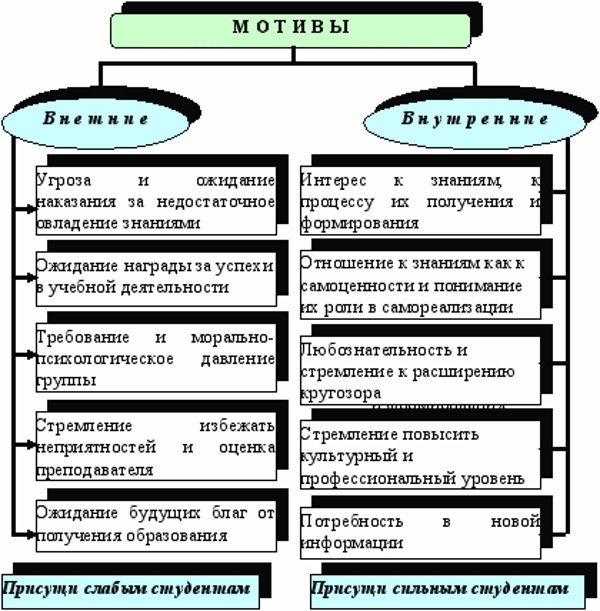
The latter play an important developmental role, forcing them to compete. What matters is public encouragement or condemnation, which is inextricably linked with the choice of an external motive. They are more effective than internal ones, therefore they are used to control the behavior of a person.
Positive and negative motives
Such factors are subject to and subject to emotional influences. They are aimed at satisfying the natural need for positive moral feelings. The desire to avoid negative emotions determines the choice of the path or sequence of actions.
Negative feelings include:
- fear;
- anxiety;
- moral torment;
- physical pain;
- the desire to avoid punishment for a misdemeanor.
The individual always subconsciously tries to choose the course of action that will provide positive emotions and exclude negative ones. Such motives are called positive or negative.
Psychologists disagree about the effectiveness of these incentives. Fear and the instinct for self-preservation are considered incredibly strong stimuli. Negative motives are aimed at overcoming obstacles on the way to the goal.
Resistant and unstable
The first are based on natural needs, needs. Therefore, persistent motives do not need additional reinforcement. They remain relevant in the long run.
Unstable motives are subordinated to situational goals and the satisfaction of momentary needs. The factors that induce action, based on worldview, personal interest, and taste preferences, are particularly stable.
Achieving Success
Based on the values promoted. Social norms encourage an individual to strive for success in life. A special system of standards has been created with an understanding of prestige and respectability.
They are equivalent to the concept of success and are aimed at creating the required incentives. The system of modern value orientations has raised a certain scale of achievements with the attributes of high social status to the top of the psychological hierarchy.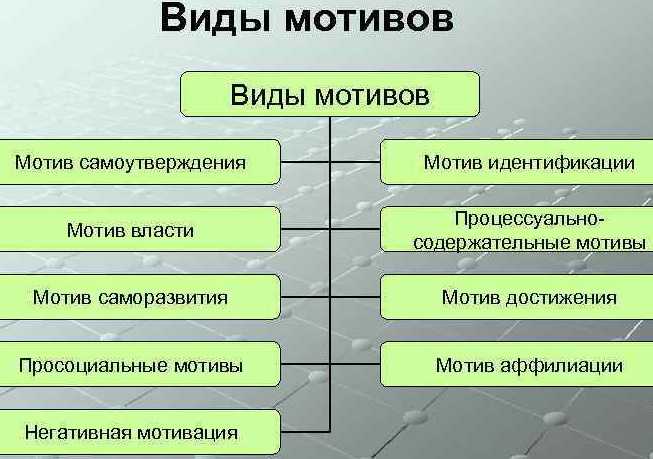
There are many obstacles on the way to success in life. Overcoming them requires powerful motivation, which consists of material wealth, personal comfort, and public recognition. To approach a distant and elusive goal, intermediate milestones are outlined. The achievement of each of them is a separate motivating factor.
In psychology, a motive is also a progressive, systematic, consistent movement towards a global life goal. This path often requires leaving your own comfort zone. It is the motive that makes a person decide on such actions.
Under the influence of a stimulus, an individual sacrifices little to solve a global problem. In psychology, a comfort zone is understood as a personal mental, physical and spiritual space, which a person is ready to sacrifice in order to achieve a goal with pending compensation.
All people declare their desire to achieve success in words, but not everyone is ready to sacrifice for it. The corresponding motive is intended to compensate for the costs on the thorny path to high social status. A hidden, subconscious stimulus often comes into play here.
Functions of motives
In psychology, extrinsic (external) or intrinsic (internal) reasons are used to explain the background of any behavior, reactions to changes in conditions or actions. They are closely related to the basic functions of motives. There are 3 of them - motivation, direction, regulation.
Psychoemotional qualities are considered to be external factors determining the behavior of an individual:
- satisfaction of natural needs;
- achievement of the set goals;
- realization of your own desires;
- following your interests or hobbies.
Behavioral stimuli are based on the functions of motives. The motivation provokes to perform certain actions, gives relevance to psycho-emotional impulses or emotional impulses.
The guiding function helps to choose the right way to solve the problem. Regulatory forces to adhere to the morals, norms and rules prevailing in the social environment or social group. It lends legitimacy to intrinsic motives.
Functions influence external stimuli in a similar way. When guided by extrinsic motives, they activate other characteristics of the individual. Therefore, motivational functions in psychology are considered in a dual context.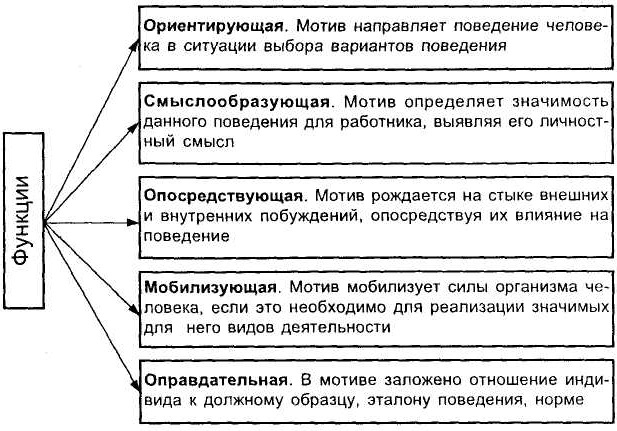
Some are biological, considered innate and provide survival. Such functions of stimulating factors are aimed at satisfying basic physiological needs - satisfying hunger, thirst, sleep.
They are inherent in any biological organism, since they are dictated by nature. Maternal instinct is considered one of the most powerful motivating factors. The biological functions of motives include thermoregulatory, excretory, the desire to avoid pain or discomfort.
People have inherent secondary stimulating factors acquired in the process of life, dictated by the prevailing external conditions, social environment. Interpretations of the functions of motives are given in the table.
| Function | Characteristic |
| Balance | It is activated when an individual is deficient in something and acts until the lost balance is restored. |
| Needs | Serves as a response to the desire to satisfy physiological, psycho-emotional, aesthetic or other needs. |
| Cognitive | Encourages the implementation of actions aimed at achieving the goal or solving the current problem. |
| Behavioral | It is dictated by social rules and norms, it can change depending on external conditions. |
The motive has selective functions and individual properties that change over time. In psychology, this is called adaptive ability. The motivating factors and their functions are not the same in terms of the strength of the impact on the personality.
Levels and types of motivation
Without connection with the stimulus that ensures the development of the individual, the levels of motivation are transformed, changing the strength of the impact. There are 2 main types of motivating factors: dictated by internal reasons or external circumstances.
The former do not allow you to give up in case of failure, the latter are aimed at achieving public recognition. According to Freud, there are male and female types of motivation.
In a simplified version, the first is focused on saving available reserves, the second - on finding additional resources and sources. Each psychological school offers its own interpretations of the types of motivation.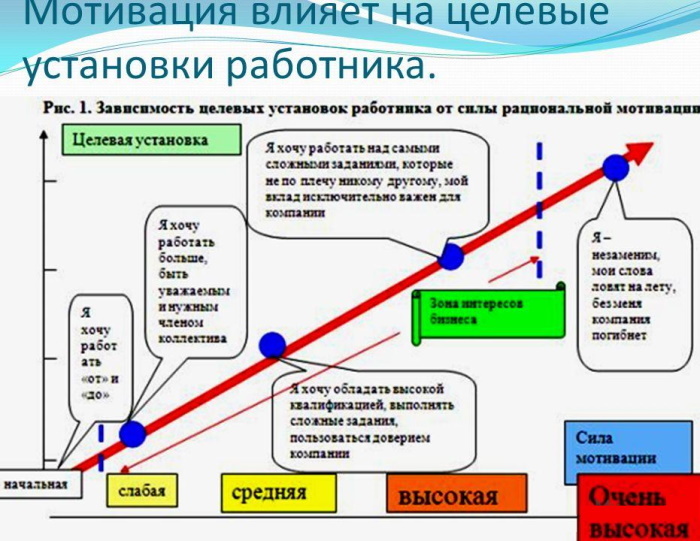
The following classification of levels of stimulating factors is popular:
- Perspective visualization. It involves the creation of a clear reference point, an image of the desired future.
- Perspective stability. The individual seeks to be confident that living conditions will remain unchanged for the foreseeable future. Both internal and external motivation is based on this.
- Revitalizing perspective. When approaching the goal, the individual subconsciously intensifies the desire to reach it, and accordingly the level of motivation increases.
- Stages. Complex goals require step-by-step planning. The proximity of each next intermediate point does not allow motivation to wane.
WITH. Polukeev based on the analysis of L. Gumilyov suggested 9 levels of motivation. Each reflects the strength of the individual's stimuli, his psychological state, the strength of his life aspirations.
Depending on the goals being realized, the tasks being solved or the actions performed, the level of motivation decreases or increases. The determining factors are considered the significance of the result, confidence in the achievement of the goal, personal forecasts regarding the possibility of implementing the planned.
The main motives of a person, examples
The main factors that stimulate and determine the behavior of an individual include those that are aimed at biological survival. They are laid down by nature and do not change by volitional effort.
Some of these motives are cyclical - food intake, sleep and wakefulness phases. Obvious examples are the extraction of food, the extraction of additional resources. The main motives stimulate the labor activity of an individual, economic processes in social formations.
The accumulation of material values, the production of basic household items and foodstuffs pursue the goal of satisfying natural human needs. This includes the manufacture of heating means. The motivation for such activity is the increase in life expectancy.
A motive is, in psychology, an individual's desire to satisfy his own basic needs. Such considerations force states to develop science, technology, medicine. Complex economic and social processes are based on a simple desire to satisfy the basic needs of all members of a social formation.
Many basic motives are not given importance in everyday life, but they are the driving force behind any activity. These stimulating factors include a subconscious desire to avoid danger, dictated by the instinct of self-preservation.
The search for shelter, the desire to protect oneself, to create the most favorable conditions for life are considered the main and fundamental motives. The main behavioral stimuli are individual psychological characteristics that have a strong influence on a person's actions in different situations.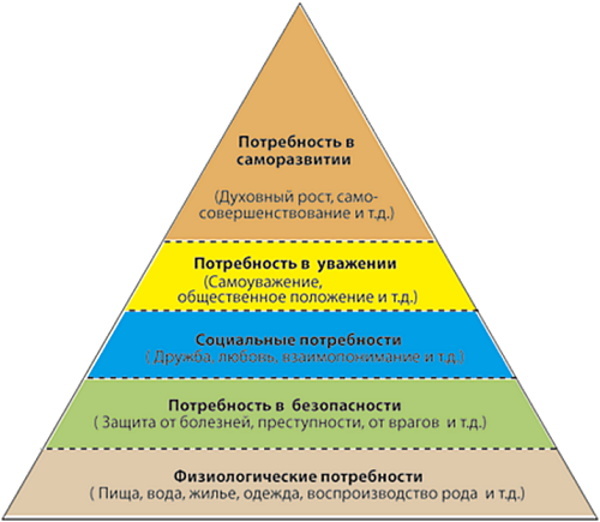
They are socially conditioned or are personal innate. Motivation can be functional and serve the purposes of the cultural development of the individual. Such incentives force people to buy expensive tickets for a concert, a theater, or a contemporary art exhibition.
What is subordination of motives?
This is a key concept in the formation and development of a personality. The first signs of subordination of motives appear at an early age. Various stimulating factors lose their equal importance, form a system of personal values, life guidelines.
This arrangement is called an individual motivational scheme. The dominant and secondary impulses make up a hierarchy, in which there is a difference in levels, strength of influence.
The subordinate motives of adolescence include:
- self-affirmation;
- striving to achieve sporting success;
- the emergence of moral qualities;
- behavioral assessment.
To prevent ethical deformation of the individual, subordinate motives are built into a hierarchical system by educational and educational means. The most difficult moment in the period of the psychological formation of an individual is the choice between personal and social values.
The subordination of motives is formed in the struggle of these factors to create a reasonable compromise. It starts at preschool age. The result of this step-by-step process is considered to be motivational readiness, which is closely related to the concepts of cognitive interest and initiative.
The problem of the struggle of motives
Simultaneously and in parallel, the individual is under the influence of numerous multidirectional stimulating factors. This is the most important concept of volitional activity. The struggle of motives is aimed at determining the dominant and dominant stimulus.
Its logical outcome is the formation of a mature personality, comprehension of life priorities, the ability to independently make decisions. Some motives are ambivalent. Example: is it worth accepting the help of an unpleasant or a priori unfriendly person.
Such dilemmas that haunt the individual throughout life are at the heart of the struggle of motives. A typical example is choosing between positive but incompatible goals. Making a decision often requires a lot of willpower. It is not recommended to make difficult life choices under the influence of emotions.
In psychology, a motive is also a constant struggle of multidirectional stimuli and impulses. A clear definition of values helps to make the right choice. Psychologists recommend drawing up a personal motivational scheme to facilitate internal struggles.
How to correctly identify motive and motivation?
Personal psychophysiological stimuli regulate the behavior of the individual, serve as the basis of the human mental sphere. Motivation is the driving force that orders the motivating factors, unites them into a coherent system.
A well-built hierarchy facilitates the achievement of goals and increases the efficiency of activities. To correctly identify your own motives, dividing them into dominant and secondary, requires deep introspection. In psychology, this is considered a fundamental factor in the formation of a harmonious personality.
Video about motives in psychology
Psychology. Motivation and motives:

